
British Army Service

This is the style currently used by Gorkha forces. The standard specifications are 15" long with a mass of about 600 g. A similar knife is issued in the Nepalese Army. The Nepalese Army knife is somewhat smaller, at about 13" and 500 g. HW
This info is from a standing Gurkha (Gorkha) Officer:
"There is a standard issue knife for both the Gurkha (sic) Regiments in both
the British and Indian Armies." (This is like HIs BAS without the scroll
work on the buttcap.)
"This kukri is kept in high polish and is used for parade, kit inspection
and the like. Our Gurkhas are allowed to carry any khukuri while in battle
dress and some of these knives are the older, larger blades from WW II and
some are actually handed down grandfather to father to son. Keen edges too
after 50 years!" Relayed by John Powell
Wilkeson
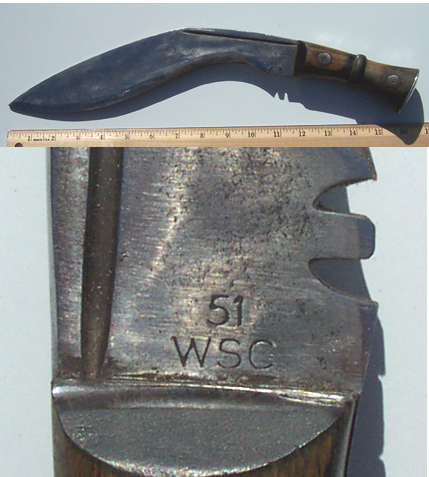
Here is an example of the Wilkinson Sword Company's ill fated kukri of
1951.
According to Ron Flook's excellent book there were 1400 of these made along
with marked karda & chakmak plus a standard scabbard. I have also been
told
there were 1200 produced. My picture doesn't show it, but there is also a
'broad arrow' above the marks.
Story has it and facts prove that this thing was hated by the Gurkhas and
they "lost" most of them. Subsequently they are rare items indeed.
K-45
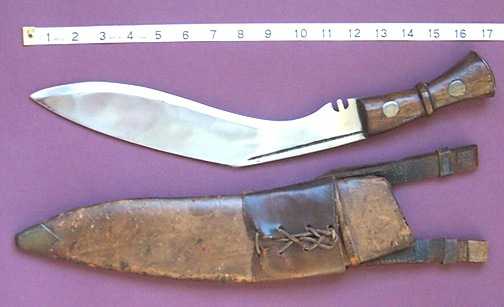
The K45 was designed and made in Rawalpindi in the later part of 1945 by
some of the "boys" from the Ordnance
Bureau and was so cost/time effective that all involved got the civilain
award
correspondent. Quite a big deal apparently. This kukri was so good it's the
one that
everyone copied and is still being made by kamis, blacksmiths, matalsmith,
etc.
everywhere and more annoyingly, by Atlanta Cutlery.
JP 3/03
WWII
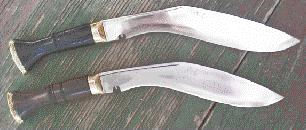
The workhorse of the Gurkas during WWII, this model saw service in both Europe and Pacific theaters. This is probably the best combination of weapon and tool that can be had. This khukuri is the favorite of many Bando practitioners.
This knife is also known as a Dheradoon, as many knives of this style were manufactured there for the Indian Army during WWII.
The WWII will usually measure 17" - 18" and have a mass of about 700 g.
Will Kwan's review of the 15" AK and the WWII
1942 Leather And Web
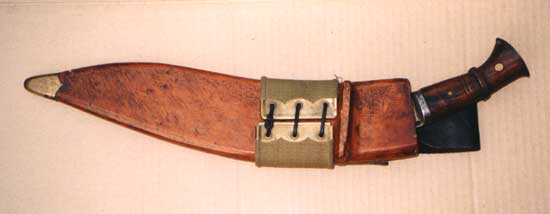
M43
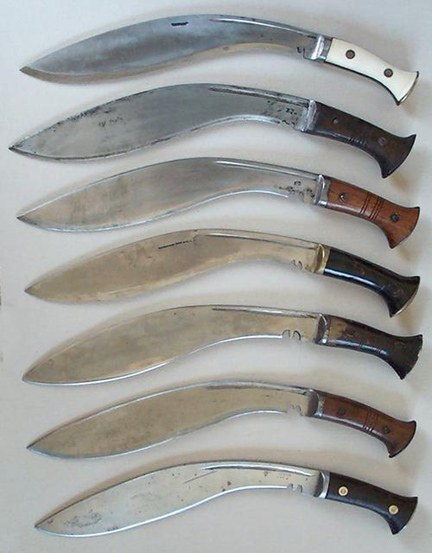
The M43 was designed as an update of the Mk II which was basically a WW
I
design. The new knife had a stronger grip attachment system, a wider pommel
and better bolster design at the blade. The balance is slightly more forward
and the blade could arguably considered stronger.

Two M43 models for comparison. Note different chos and black painted handle. All forward curving blades aren't necessarily ancient.
Specs for a Standard M43, referenced to the chart on the bottom of the page.
A. 2 5/16"
B. 13 1/8"
C. 3 1/2"
D. 17 1/2"
E. 4 1/8"
F. 5/16"
G. 1/4"
W. 1 3/4+ lbs"

Five officer's khukuris. Note forward curving at top and transition to "shouldered" blades.

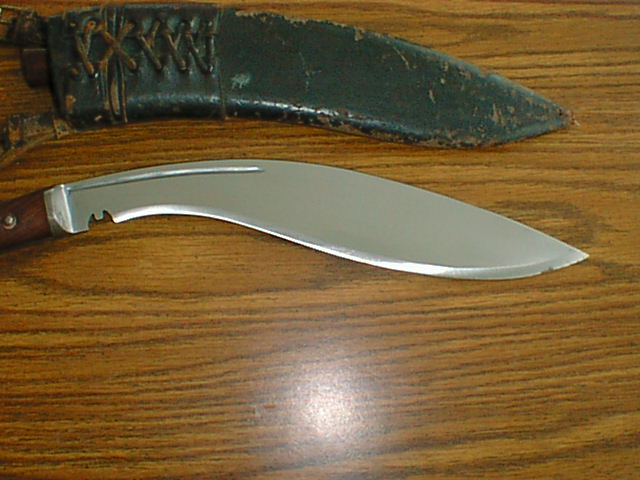



Some nice shots of a M43.
This is not John Powell's, but it is from another private collection.
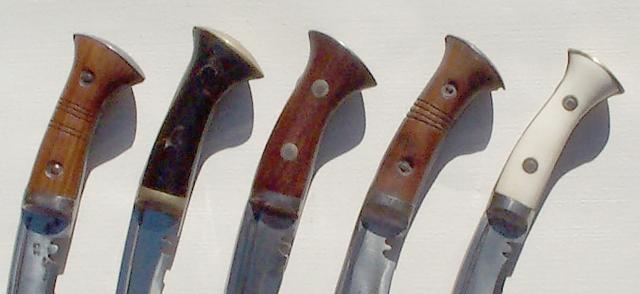
Most of the M43s have some sort of version of the rings (4 or 5) cut
into the grip. In some cases the tang is cut also. One of the best things
about the M43 is the thickness of the blade which gives the knife a great
'feel'. It appears the fancier knives don't have the rings.
Post WWII officer's knife
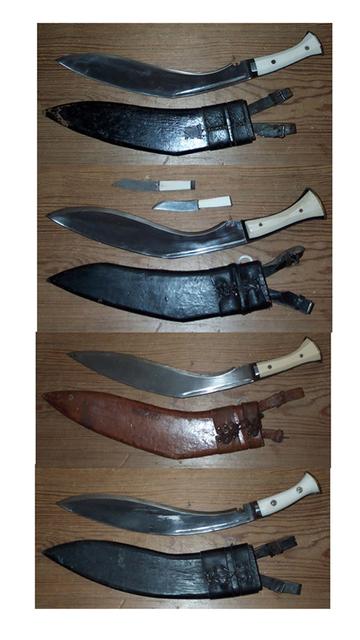
Here are some examples from just post WW II, made for an officer or senior
NCO in the Gurkha regiments that stayed in India after independence. It may
have been made by a contractor who had supplied issue kukris.
These were rarely if ever used, so pristine condition is not uncommon, but
they almost always have their scabbards. Made in India, most of this style
did not have a karda or chakmak nor a tinder pouch. Many had a combination
horn and ivory scales.
The scabbard styles which are very flat and precise.
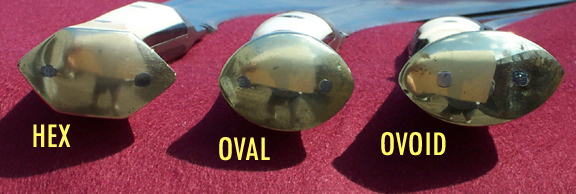
These knives were made as showpieces rather than working knives. I hesitate to use the term "WW II style" since these are much thinner but still have the classic shape of many other and earlier khukuris. These blades are more like cutlery than the usual military or village models and as with any khukuri you will find variations and subtleties that were up to individual makers. There are few hard rules when it comes to making these things.
The difference in grip and pommel shape is a matter of workmanship. I have found that the hexagonal shaped examples are usually the finest made pieces with the oval and ovoid equally well made, but without the 'finesse'. You really have to hold these models and compare them to feel all this.
JP 9/01
WWI
1915 Leather And Web

Between the wars

This style is described in my reference material as:
"...a complete mystery with regard to the unit/troops they were made for,
(they) have been seen in a photo showing BRITISH and Gurkha troops wearing
them in India between the wars. They are also unlike other khukuris in that
they can be used in a stabbing mode and are accompanied by a sheath of a
different design from the norm."
I have never seen this knife before in the flesh. My particular piece had
a
black painted grip once, is marked 1920, and came with the remnants of a
sheath. This grip also has slight finger grooves.
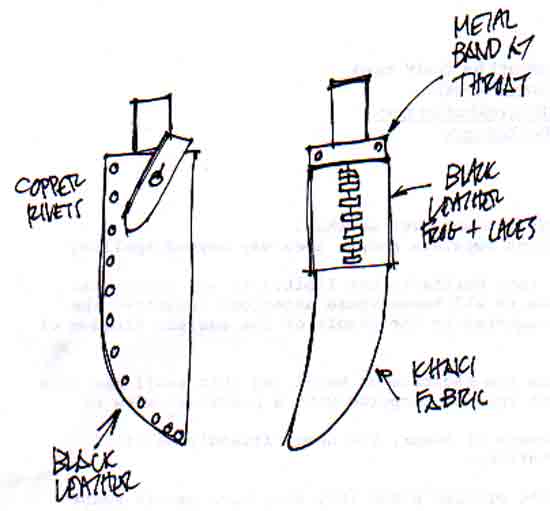
There were literally just remnants of the sheath for the above knife,
but I here are drawings of the 2
types of known sheaths.
Comparison
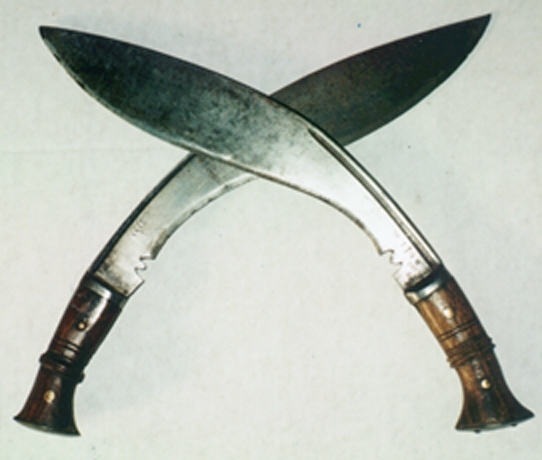
'crossed knives' is a good (but fuzzy) comparison of a WW II blade on the
left, and a WW I blade. Both are very similar in weight and construction
being typical B.P.I.P. items.
WWI with Fitted Sheath
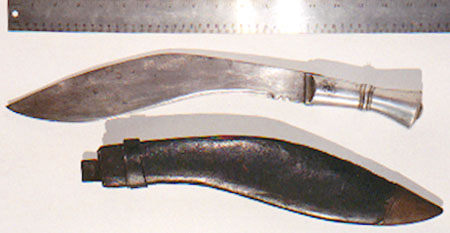
A WW I khukuri with a fitted sheath that allow the knife to be pulled out
of
the back. These are attributed to the Maharajah of Jodphur for the Gurkha
regiment he sponsored for the "war effort" in France.
Pretty crude with an alloy (aluminum?) handle and a non fullered, flat
blade
that is slotted into the grip. The blade is a touch over 3/16th wide at the
ricasso and the belly. Overall length of 19".
The blade shape is interesting in that it follows the profile of some very
early khukuris with an almost upturned tip. Very shallow cho with no marks
on this particular piece. I have seen the same model with a royal crest and
with regimental inspectors marks but never a broad arrow.
This model is quite rare and is only the 5th one I've ever seen. The others
being in the British museums (Gurkha, Army and Imperial War).
MK I (WW1)

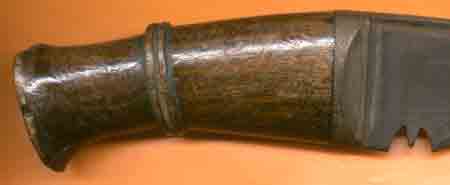
Attached pictures are of a MK I from the WW I era with some unusual
features as compared to
the 'standard' B.P.I.P pieces. For one the weight is a good quarter pound
heavier, and the width at ricasso is 4.2/10" vs
3.1/10". This is a solid knife that is the same length but has a one piece
walnut grip held on with a slotted machined nut. Like most (all?) of the
B.P.I.P. blades it is machine made. No scabbard unfortunately,
but the pattern is only slightly different than the standard with a canvas
cover and leather frog. I have been hoping to find one these as it is
referred to in some of my books, but is considered on the rare side. I have
seen these in photos and the overall shape and look is so different yet so
classic khukuri. As you can tell, I am very pleased with this 'surprise'
knife. This was in my bundle of joy from the UK that held that nice tin
chirra. I blind bid on these and got 4 very nice khukuris for $75 each.
specs:
A 2.5"
B 13 5/8"
C 3 7/16"
D 17.75"
E 4"
F 4.2/10"
G 3.1/10"
W 1.75 lbs
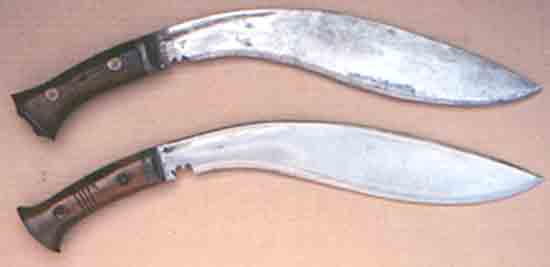
WW I compare:
has the top knife being the anomaly. It weighs 1lb 12oz vs 1.7 for a typical
B.P.I.P. and even though it's hard to see in the photo a more pronounced
'drop' of 3 7/8" vs 3 5/8" Doesn't seem like much, but if you handled these
you'd be amazed.
John Powell on khukuris from the WWI and WWII eras
I met with the curator of the Gurkha Museum for an at length meeting, the
Oriental Arms expert at the British Museum, pattern director at the British
Army Museum, spoke with the V&A arms folks, the Royal Armories, my Gorkha
friends and a standing Gorkha Major. I also spoke with 4 major dealers and
had the good luck to be there for the Arms & Armor Fair that was being
held
(our gun/knife shows pale very badly in comparison).
Bottom line: extensive and precise information available on the military
khukuris and very, very little on 'civilian' pieces. Even the kothimoras
have little provenance and info as to maker, location, types of steel, etc.
When talking about khukuris they have to be separated into two distinct
groups. Military and 'civilian'. Even if some of those old pieces were no
doubt used as military kit.
I have a lot of information to disseminate, but here are some highlights:
1. The same pattern was used for both WW I & II scabbards in many cases.
2. WW I scabbards aren't found with frogs in many cases because they were
made of web material and were required to be turned in upon leaving the army
as
part of all the whole 'kit'.
3. Sheffield made blades in WWI. Wilkinson made blades for a short time
starting in 1951. Apparently they sucked big time and the Gorkhas threw them
away.
4. If the scabbard is covered with canvas or webbing it was probably a WW
II
piece used in the CBI Theater. The European Theater saw 'naked' scabbards.
WW I
scabbards rarely had complete coverings.
5. The blade marking system is decipherable but varies by year and whether
the blade was from India or made in Nepal and stamped in the UK.
That's a whole chapter.
6. The panna butta style grip was favored by many Gorkha troops as was wood.
"Bone doesn't absorb blood or sweat as readily" is one quote that comes to
mind. Then why are bone grips and rattail tangs the norm? No good answer.
7. There is always one khukuri for parade, and one for use. The scabbard is
now patent leather, but the knife is still perfectly usable.
8. The Brit military broad arrow was never used with just the word "India"
but was used during Indian manufacture. Sometimes you will see a knife with
the
word "India" stamped over old markings and a broad arrow however. This is
a
legit WW II blade. Like I said, a whole separate chapter.
6. Rounded, or 'no shoulder' blades were manufactured through WW II.
7. The cho on (mostly) WW I blades is indicative of the regimental kami and
reflects where he was from in Nepal.
Currently, all official issued khukuris for the Royal Gurkha Regiment are manufactured at The Brigade of Gurkhas Depot, Dharan in eastern Nepal. The Nepalese do their own thing as usual and I have been told that the Indian Army continues to manufacture in Dehra Dun. Note spelling of Gurkha vs. Gorkha. If the Brits are involved it's the former. Indian or Nepalese, it's the latter.
During WW I knives were made at various depots in India, Nepal and even
Burma for the 10th Gurkha Rifles. The steel came from "condemned carriage
springs from the Insein (not a pun) Railroad Works." 'Yindek' and 'Simal'
were obtained from the jungle for handles and scabbard
frames and goatskin from the bi-weekly meat issue was rough tanned for scabbard
coverings, frogs and tinder pouches. Some knives did come from the
UK or under contract through Sheffield
though not marked as such, but can be recognized by how "machined" they look
with a very precise fuller, threaded tang and tang nut.

During this period the Maharajah of Jodphur had khukuris fitted with an alloy/white metal grip for the regiment he raised to fight in France (under the 1st GR I think). There is some agreement that this distinctive tradition carried on post war. These knives can be recognized by a plain (no decoration) solid alloy grip, very slight or no 'ring' and some had brass bolsters and buttcaps. The scabbard may be dark brown leather with straps and buttons used as the retainer for a frog that is laced. 2 adjustable straps secure the scabbard to the belt. There would be a chakma and karda or 2 kardas.
Both wars saw the use of wood grips although some aluminum/alloy is seen and 'officers' models could be fitted with horn or ivory. The grips were either 'pana butta' (scales) or one piece being secured in one or two spots with a steel or brass buttcap. E.P.I.P. (or B.P.I.P) knives produced late in WW II had horn handles. One of the rarer of these models having a completely smooth pana butta grip. Scabbards were made of flat slabs of wood covered with tan or brown leather and many of the frogs were of web material. WW II saw more rounded scabbards and more black dyed leather covers and frogs. The frog became a much more integral part of the sheath. Many of these pieces were painted with black dye rather than tanned that way. Many war issue khukuris had no chakma or karda although some show up with the pieces jammed in the fold between frog and scabbard and not in individual pockets.
The marks on the blades vary widely, but these are guaranteed Indian produced
marks:
an I with the broad arrow over it.
an I (broad arrow) and the letters G or D or IG or SA to the on the
other side.
23 or 20 or 21 are Indian Government ownership or inspection marks.
C (broad arrow) 15, C(broad arrow) 544 and P (broad arrow) 5 are acceptance
or inspectors marks.
dates are also stamped as 1915 or 15, plus regimental and brigades 1/3
or just 3, etc.
43, 44 with an M over the numerals and M41 (as shown) or just 1941.
Scabbards were stamped also and rarely match the knife. On WW I models look
on or above the small brass chape for inspectors marks also. Post war
and WW II models also had the scabbards marked under the frog or behind the
belt loop.
What Yvsa calls the "drop" is the distance between the top edge of the
spine and a straight edge layed across the edge to the bottom of the butt
cap.
One of the fastest ways to identify a very old khukuri is by this 'drop',
even more so then handle size. An old handle will always have a very pronounced
curve regardless of length or width. I think the pictures will show you that.
These old blades with no shoulder evolved into the more traditional pieces
with a stronger and straighter spine.
Afghan military khukuri ,1895
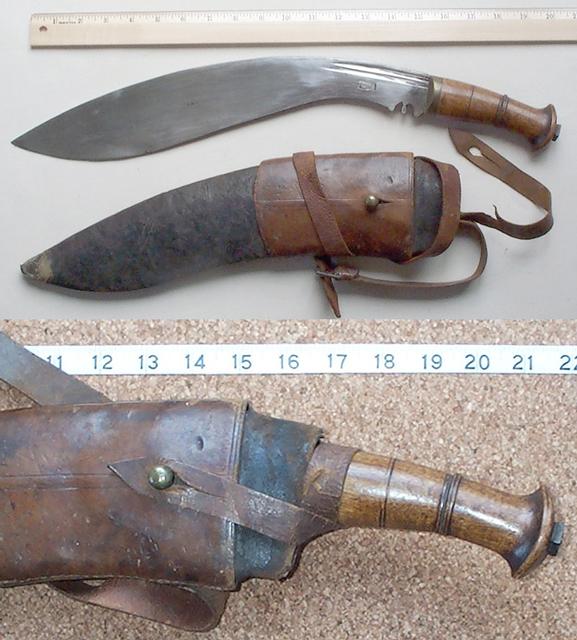
Here is a very interesting khukuri that is armory marked and dated. Besides being a massive piece the design is interesting with the square nut holding the uniquely shaped grip. The other feature besides it being 'backward' is the leather retaining strap at the base of the grip (shown in closeup) that is very secure. There is no provision for a karda and chakma, the carrying straps and frog are very well made as is the blade. JP
1870-90 10th GR Kubo Valley
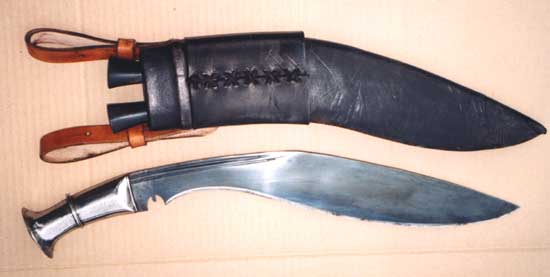
1870: blade and design from 1860 through 1890. This one is unique in that
the
grip is solid metal and the blade was once blued according to despatches (sic)
from a British
Officer in Burma who described "the tough little Goorkhas...and their smart
kit...with
black blades and bright handles". These men were members of the Kubo Valley
Military Police
Regiment (officially named in 1886). (Burma Service) This same unit
was absorbed by Princess Mary's
Own Gurkha Rifles in 1906. The history of these police groups is quite
extensive and specific mention is made about the "crispness of their kit",
"bright leather belts" and "distinctive gleaming metal handled kookries"
with "blackened blade".
All specs and descriptions taken from museums and dispatches from the 1870's and 1880's. The light straps on the frog have been reconstructed from photos and written descriptions . The karda and chakma are from Himalayan Imports and are a best guess as to size.
OAL: 19 3/8"
BL: 15 1/2"
GL: 4 1/4"
Drop: 3 1/2"
Belly: 2 3/8"
Width at ricasso: 3.5/10"
" " belly:
3/10"
Weight: 1lb 15oz
This was a knife used by the Burma Military Police (Kubo Valley Police
Battalion) between 1887-1890.
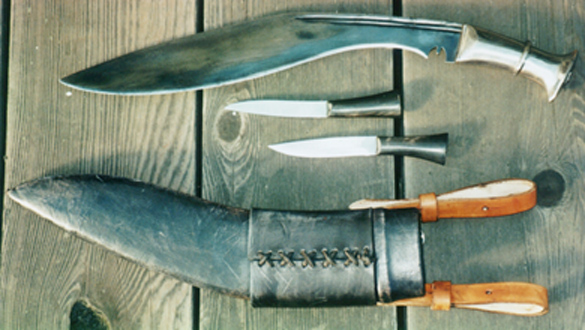
1845 Sirmoor Battalion
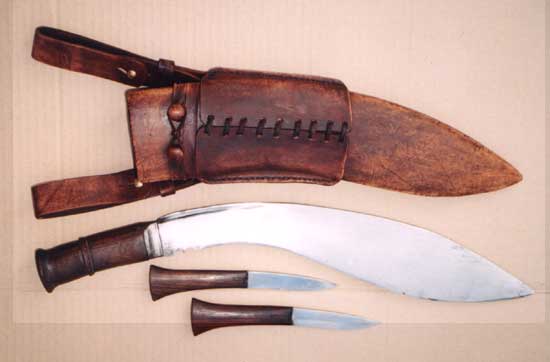
1845: an old knife with a unique 'straight' or 'barrel' handle, rising
spine
(rare) and shallow cho. The present scabbard was reproduced from
a blueprint for the scabbard that I had the good fortune to see at the Gurkha
Museum and in old photos of the Sirmoor Regiment (became the 2nd Prince of
Wales Own Gurkha Regiment in March of 1876)
OAL: 18 1/8"
BL: 14 1/8"
GL: 3 7/8"
Drop: 3 1/2"
Belly: 2 5/8"
Width at ricasso and belly: 2/10"
Weight: 1lb 5oz
Khukuri Measurement Chart.
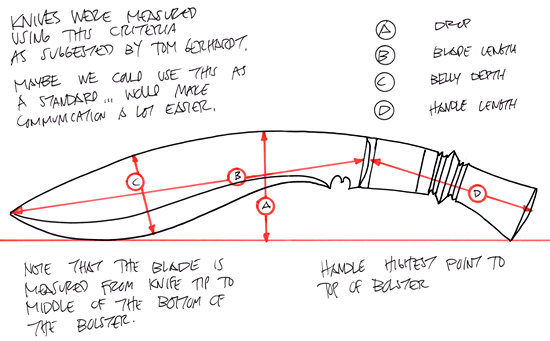
All content on this WebSite is copyright 2010, Himalayan Imports
Some disreputable firms have copied pictures of Himalayan Imports' products off our website, and have used them
in their own advertisements to pawn off lesser-quality khukuris on unsuspecting consumers!
Please inform us if you discover illicit use of our content.
Original site design by
Benjamin Slade
Daniel Koster
Bill Martino
w/ many suggestions from Himalayan Imports Cantina regulars